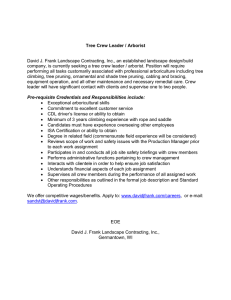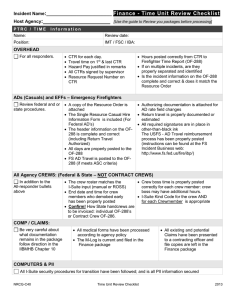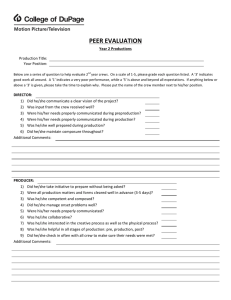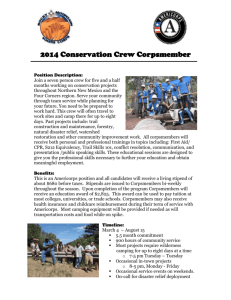CHAPTER 60 PERSONNEL 61 General
advertisement
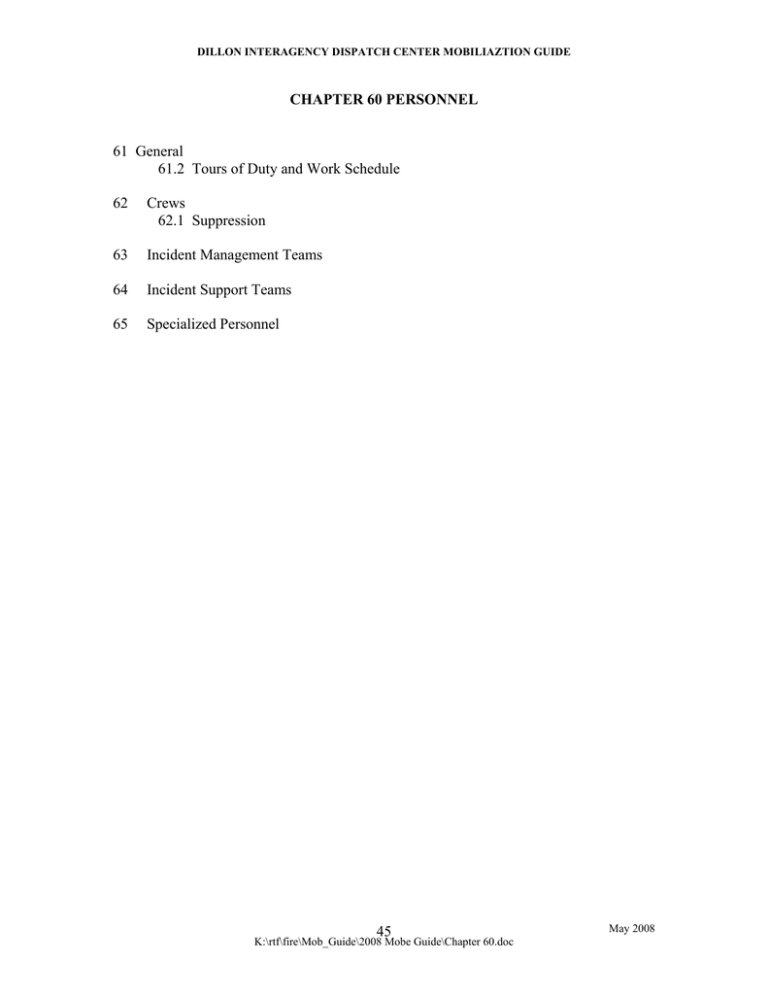
DILLON INTERAGENCY DISPATCH CENTER MOBILIAZTION GUIDE CHAPTER 60 PERSONNEL 61 General 61.2 Tours of Duty and Work Schedule 62 Crews 62.1 Suppression 63 Incident Management Teams 64 Incident Support Teams 65 Specialized Personnel 45 K:\rtf\fire\Mob_Guide\2008 Mobe Guide\Chapter 60.doc May 2008 DILLON INTERAGENCY DISPATCH CENTER MOBILIAZTION GUIDE 61 General DDC will only dispatch individuals that have current Incident Qualifications Cards. Individuals must meet qualifications listed in the 310-1 Fire Qualifications Handbook and in the case of Forest Service employees the 5109.17 and any additional requirements set forth by agency direction which includes fitness requirements and annual refresher training. In the event any emergency fire crews are recruited for fire suppression they will receive S-130, S-190, L-180, I-100, IS-700 and RT-130 prior to being assigned to fires. All individuals recruited will comply with the fitness standards of the recruiting agency. No emergency crews will be recruited or trained until DDC has established that adequate qualified supervision is available. 61.2 Tours of Duty and Work Schedule When fire danger warrants (usually the first week of July), the Interagency Dispatch Center will be operated on a seven-day per week basis with hours from 0730-1830, Sunday through Saturday. This schedule will be maintained at least throughout the summer months and into the fall as fire danger dictates. During periods of high fire danger or as Northern Rockies Planning Levels dictate operational hours will increase to meet the needs of the Interagency Cooperators. The Center Manger or acting will adjust work schedules as needed to meet demand and order additional dispatchers as needed. 62 Suppression Crews (Type I and Type II) a. All standby for Inter-regional Crews (Type I) will be governed by the Region-wide or Inter-Regional fire situation and controlled by the Northern Rockies Coordination Center. The Northern Rockies Mobilization Guide contains the locations and days off schedules for the Type I crews in Northern Rockies. b. Tours of duty for District suppression forces should be staggered to the extent possible. c. The Forest should usually be able to provide one Type II crew for offForest dispatch. Crew name for Forest Type II (regulars) crews will be the Forest name plus the number of the dispatch of regular crews for the Forest. Example: First crew dispatch would be Beaverhead-Deerlodge #1; sixth crew dispatch would be Beaverhead-Deerlodge # 6 Crew Name for Job Corps will be the Center name plus the number of the Dispatch of crews from the Center. 46 K:\rtf\fire\Mob_Guide\2008 Mobe Guide\Chapter 60.doc May 2008 DILLON INTERAGENCY DISPATCH CENTER MOBILIAZTION GUIDE 62.1 Crew Optional Guidelines 62.11 Policy and Scope This plan provides management guidelines for all Type II and camp crews mobilized by the Dillon Interagency Dispatch Center (DDC). DDC is responsible for mobilization of crews comprised of personnel from cooperators and the Job Corps. The crews may be comprised of regular federal government, state and county employees. Generally, the Beaverhead-Deerlodge National Forest will be able to sponsor one Type II suppression crew and occasionally two crews. Although the suppression crews will consist primarily of Forest Service employees, they may also include individuals from other cooperators. The Anaconda Job Corps Center (Job Corps) may also sponsor one or two camp crews and miscellaneous suppression resources. These crews are generally comprised of AD firefighters from the Job Corp that are supervised by overhead supplied by the Job Corps and/or Beaverhead-Deerlodge National Forest. 62.12 Objectives • To provide an organized, disciplined and effective fire suppression crew that will fight fire aggressively and safely. • To provide proper training regarding fire fighter safety through exposure to a variety of fire suppression strategies and tactics. • To provide fire suppression, fire behavior, fire ecology training and experience and increase awareness of the role of fire in resource management. • To provide camp crews to assist with logistical functions. 62.13 Crew Composition and Responsibility Only qualified personnel will fill crew overhead and crewmember positions. This includes meeting the physical fitness standards and having a current ICS qualification card for the position that they are assigned. PMS 310-1 and FSH 5709.17 qualification standards that will be used in accordance with each agencies policy. 47 K:\rtf\fire\Mob_Guide\2008 Mobe Guide\Chapter 60.doc May 2008 DILLON INTERAGENCY DISPATCH CENTER MOBILIAZTION GUIDE Suppression Crews Crew organization will follow National Mobilization Guide directions on page 355, section 62.2. See Appendix D for a list of crew positions as required ICS qualifications. Minimum crew size will be 18 for assignments outside of the jurisdiction of DDC. Crews that fall below 18 or the crew boss becomes unavailable may be returned home at the discretion of the incident commander. Crew bosses are responsible for managing all aspects of the crew assignment. This includes thorough and timely coordination with DDC and crewmembers. Once the crew boss has been notified of an assignment, the individual should be in communication with the squad bosses and crew boss trainee as soon as possible. A high level of communication with the crew and DDC should continue throughout the assignment. Crew boss, squad boss and crewmember responsibilities can be found in the Fireline Handbook. Crews may be dispatched with chainsaws when qualified sawyers are requested and available. A saw squad will be formed when chainsaws are assigned. Appendix D displays the crew composition and minimum qualifications for using chainsaws. In situations where the crew will be traveling by air and are not permitted to transport chainsaws, a saw squad may still be assigned with the intent being that the crew will order saws when they reach the incident. Camp Crew Each camp crew or kitchen crew will have one camp crew leader assigned with up to nine crewmembers in a crew. The camp crew leader is responsible for the work effectiveness, safety; conduct welfare, discipline, and leadership. The Camp Crew Boss (CACB) will report directly to the Facilities Unit Leader. See FSH 5109.17 for qualifications. 62.14 Anaconda Job Corps In order to maintain administrative oversight for a crew comprised primarily of Job Corps students, at least one Anaconda Job Corp employee will accompany the crew. The Job Corps employee may fill this role as the crew boss, camp crew leader, crewmember, or as a crew representative. Employees filling this role will need to meet the physical fitness standards and IQCS qualification standards for the position they are assigned. 48 K:\rtf\fire\Mob_Guide\2008 Mobe Guide\Chapter 60.doc May 2008 DILLON INTERAGENCY DISPATCH CENTER MOBILIAZTION GUIDE 62.15 Crew Dispatch Procedures All crews are ordered through DDC and are dispatched to incidents by DDC. When there is an order for a crew, DDC will contact the field unit’s fire duty officer with a request to fill crew overhead positions and crewmembers positions. The unit fire duty officer will select the individuals for assignment from the unit’s availability list and provide the names to DDC. All crew members will carry a photo ID. DDC will assign the crew boss, crew boss trainee and squad bosses for all crews based on the availability information provided by the field units. DDC will also assign the crew members to squads except for squad members for Job Corps crews. The Job Corps will select crewmembers for the squads for Job Corps crews. For regular crews DDC will distribute the crew assignments evenly among the participating units as much as possible. Table 1 provides a recommendation of how the crew assignments may be distributed among the units. If a unit (s) is unable to fill their share of the positions for a crew assignment, DDC will contact other units to fill the slots. TABLE 1. Crew Positions for Each Unit (Excluding Job Corps and emergency AD) Crew Positions Unit Dillon R.D. Wisdom/Wise River Butte/Jefferson Madison Pintler DDC (other cooperators) 3 4 4 3 3 3 Once a crew has been established, all crew members and overhead will rendezvous at a prearranged time and place before traveling to the incident or airport. This meeting location will generally be at DDC or at one of the Forest Service offices that is on the travel route. It is the responsibility of the crew boss and DDC to coordinate the rendezvous place and time with other crewmembers. It is the responsibility of the sending unit to make transportation arrangements for individuals from their unit to the crew rendezvous point. Crew boss kits will be constructed by DDC and available for use if requested. If a kit is checked out from DDC after the assignment, the kit will be turned into DDC where it will be restocked and be available for the next assignment. DDC will provide a crew manifest to the crew boss. The manifest will identify each crewmember’s position and will include the following: crew boss, crew boss trainee (optional), squad A (saws), squad B, and squad C. 49 K:\rtf\fire\Mob_Guide\2008 Mobe Guide\Chapter 60.doc May 2008 DILLON INTERAGENCY DISPATCH CENTER MOBILIAZTION GUIDE 62.16 Training Large fire assignments are critical in acquiring experience and expertise needed to meet requirements for maintenance or advancement of IQCS qualifications. Individuals participating in crew assignments will be able to take advantage of the training opportunities. Crew assignments will provide the experience required to advance to squad boss, crew boss and strike team leader. Crew assignments will also provide a portion of the experience needed to meet prescribed fire qualifications for burn boss and ignition specialist positions. The most important aspect of crew assignments will be the opportunity to become familiar with the application of the Ten Standard Fire Orders and Eighteen Watch Out Situations in a variety of fuel types and fire behavior situations. This type of experience is a valuable asset in developing safe fire fighting habits and will be the number one priority regarding crew training. DDC will be responsible for assigning a crew boss trainee. Once a crew boss trainee has received an assignment, that person will be rotated to the bottom of the list. The crew boss trainee list will be reviewed and updated annually by the DDC Interagency IQCS Qualifications Committee. It is important that the crew boss trainee be given as much opportunity as possible to function in the crew boss role while being loosely supervised by the crew boss. This training should begin in the initial dispatch phase when there is a need to coordinate with DDC, organize the crew, and obtain supplies and equipment. The trainee should be given the opportunity to supervise and manage the crew throughout the assignment and close out with DDC when the assignment has ended. It will be the responsibility of the crew boss to identify squad boss trainees and assign them as a trainee working under a qualified squad boss. Individuals desiring to work in a trainee position are responsible for bringing an initiated task book and insuring their supervisor is filling out the books as they complete the required tasks. Completed task books will need to be submitted to the DDC fire training office and Interagency IQCS Qualification Committee for final certification. 62.17 Equipment The home unit will issue line gear, fire clothes, personal packs, sleeping bags and personal tents. Firefighters should leave their home units “fire ready”. It is the responsibility of the crew boss to conduct an inspection of all crewmembers for proper PPE and gear before leaving for the incident. This inspection will be conducted at the rendezvous point. 50 K:\rtf\fire\Mob_Guide\2008 Mobe Guide\Chapter 60.doc May 2008 DILLON INTERAGENCY DISPATCH CENTER MOBILIAZTION GUIDE Everyone on the crew will adhere to the weight standard of 65 pounds total for all personal and line gear. The composition of tools to be carried by the crew will be determined by DDC and/or the crew boss depending upon the information available at the time of the dispatch. It is the crew boss’s responsibility to assemble additional supplies that the crew may need such as water, food rations, radio batteries etc. DDC will coordinate with the crew boss and sending units regarding any gear or weight restrictions associated with air travel. A minimum of four king radios will accompany each 20 person suppression crew. Crew bosses are responsible for keeping their crews properly supplied with gear and equipment while on an incident. Whenever possible, a crew should replace damaged, lost or worn out items before leaving an incident. If this is not possible, the crew boss should obtain an “S” number from the incident so that any needed replacement supplies may be ordered when the crew returns home. Chainsaws may accompany a crew when qualified personnel are present and travel restrictions allow for saws. Generally, two chainsaws will accompany a crew. It is the responsibility of the two lead sawyers (FALB) that have been assigned, to bring the saws, gas & oil, and other equipment needed from their home unit. DDC will coordinate with the sending units when assigning individuals to the sawyer positions during the initial formation of the crew. It is the responsibility of the crew boss and saw squad boss to follow up with the individuals who have been assigned to these positions to ensure that they are bringing all the necessary gear. See Exhibit B for a crew equipment list including a recommendation for the type of chainsaw and accessories. 62.18 Performance Evaluations and Monitoring Evaluations of the crew and crew boss performance will be obtained from the appropriate incident overhead. Each person that fills a crew overhead position will be rated by the crew boss. Each crewmember will be rated by crew overhead. DDC center manager will monitor crew ratings, performances and inform the Interagency IQCS qualifications committee of performance problems. DDC will forward a copy of ratings to each crew member’s home unit. 63 Incident Management Teams Nothing in addition to the Northern Rockies Interagency Mobilization Guide found at: http://gacc.nifc.gov/nrcc/dispatch/mobeguide/Chap_60.pdf 64 Incident Support Teams Nothing in addition to the Northern Rockies Interagency Mobilization Guide found at: http://gacc.nifc.gov/nrcc/dispatch/mobeguide/Chap_60.pdf 51 K:\rtf\fire\Mob_Guide\2008 Mobe Guide\Chapter 60.doc May 2008 DILLON INTERAGENCY DISPATCH CENTER MOBILIAZTION GUIDE 65 Specialized Personnel Nothing in addition to the Northern Rockies Interagency Mobilization Guide found at: http://gacc.nifc.gov/nrcc/dispatch/mobeguide/Chap_60.pdf 52 K:\rtf\fire\Mob_Guide\2008 Mobe Guide\Chapter 60.doc May 2008

